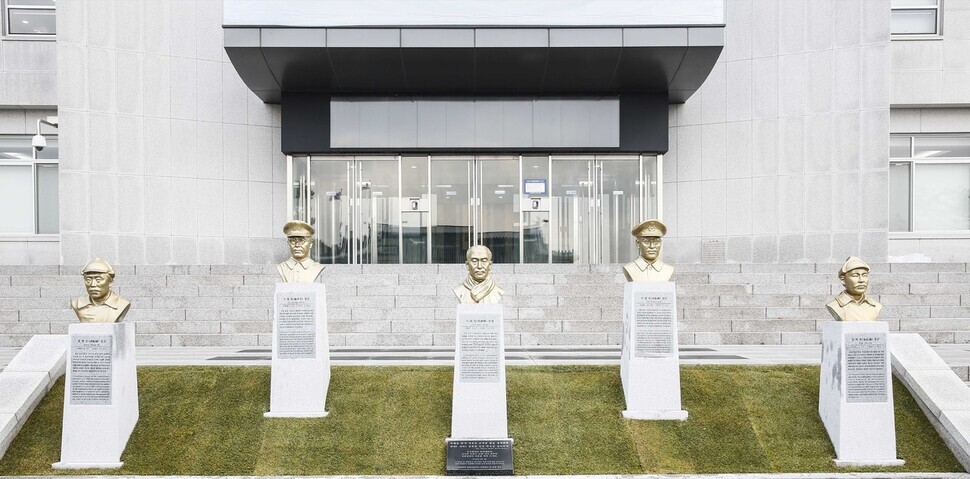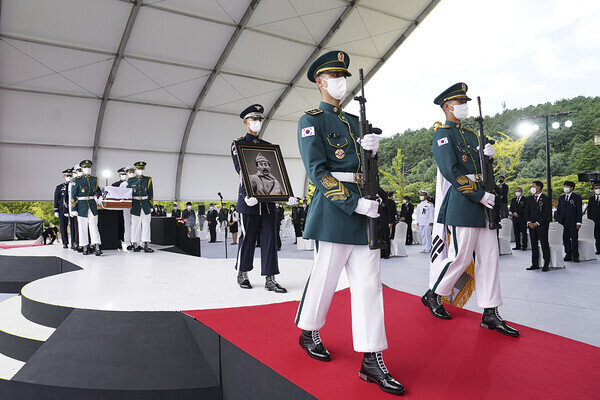hankyoreh
Links to other country sites 다른 나라 사이트 링크
Controversy erupts over Korea Military Academy's hints at removing busts of independence fighters

The Korea Military Academy is reportedly considering taking down the busts of heroes of the Korean independence movement erected on its campus and replacing them with the bust of a general who served in the Manchukuo Imperial Army of Imperial Japan.
Organizations dedicated to honoring independence activists through memorial projects expressed their strong opposition, calling the move an “anti-constitutional measure that negates the historical legitimacy of the Korean Army.”
“The Korea Military Academy (KMA) is moving forward with a plan to refurbish various memorials on campus that commemorate the history and tradition of the military,” the academy wrote in a statement to the Hankyoreh on Friday. “Among them, the busts of Korea Independence Army and Korea Liberation Army heroes installed in front of the main entrance to the building where cadets study have stirred controversy concerning the propriety of their location, as well as their limitation of our history of overcoming national crises to a certain time period. As such, the KMA is reviewing the optimal place to relocate the busts to, where a majority of the public will find their placement appropriate.”
On the same day, Defense Minister Lee Jong-sup confirmed the academy’s plan while appearing before the National Defense Committee at the National Assembly, stating, “There are plans to refurbish memorials on the KMA campus.”
The KMA has reportedly put out feelers about storing and displaying the busts in question at the Independence Hall of Korea.
The defense minister added, “The question of whether someone with a history of communism should be memorialized [on the KMA campus] was raised,” seemingly referring to Gen. Hong Beom-do, who engaged in the struggle for independence within Soviet Union territory.
The busts of Korea Independence Army and Korea Liberation Army generals such as Hong, Kim Jwa-jin, Ji Cheong-cheon, and Lee Beom-seok, as well as Lee Hoe-yeong, the founder of Shinheung Military Academy, were made by melting roughly 50,000 empty 5.56mm rifle shells totaling 300 kilograms used by South Korean military personnel to commemorate the 99th anniversary of the March 1 Movement in 2018.
At the time, the KMA shared that the shells were used as material for the busts “in order to pay tribute to the spirit of our fellow soldiers of days past who sparked the embers of national independence by defeating the Japanese military on the Manchurian plain in the Battle of Bongodong and the Battle of Cheongsanri even though they were not provided with proper firearms and live ammunition.”
The KMA is reportedly reviewing installing the bust of Gen. Paik Sun-yup, who served as a second lieutenant in the Gando Special Force of the Manchukuo Imperial Army, once the busts of Korea Independence Army and Korea Liberation Army generals are taken down from its campus.
In its statement, the KMA explained, “We are moving ahead with the plan to refurbish memorials on the KMA campus with a focus on embodying the academy’s identity and its purpose of establishment as well as on creating the optimal environment to convey the value and significance of protecting liberal democracy and the South Korea-US alliance.”
The academy continued, “In order not to confine our history of overcoming national crises to a certain time period in educating our cadets, we are reviewing making over the lobby and the hallways in all floor levels of Chungmu Hall, where cadets study, from the basement level to the fourth floor, as a space where they can learn our history of overcoming national crises in its entirety, from ancient to modern times.”

A source well-informed of military affairs commented, “I believe the KMA is reviewing installing a bust of Gen. Paik.”
According to a report investigating pro-Japanese and anti-national activities during the Japanese colonial period published by the Presidential Committee for the Inspection of Collaborations for Japanese Imperialism in 2009, Paik “cooperated with [Japan’s] war of aggression as an officer of the army of Manchukuo, a de facto colony of Japan, from 1941 to Japan’s defeat in 1945.”
The report further notes, “In particular, [Paik] proactively collaborated with Japan in its war of aggression as an officer of the Gando Special Force, a battalion made up of Koreans which militarily suppressed anti-Japanese forces from 1943 to 1945.”
In his autobiography, Paik himself wrote, “Among the guerillas I chased, many were Korean. Though we were serving different causes, as I suppressed Koreans fighting for our independence as a Korean, I had completely fallen into the trap of ‘using one’s enemy to defeat one’s enemy’ set up by Japan.”
Regarding this, a KMA official said many figures are currently under consideration, adding, “We are reviewing figures who embody the KMA’s identity as well as its purpose of establishment and convey the value and importance of the South Korea-US alliance and protecting liberal democracy.”
Organizations committed to memorializing independence activists expressed their fierce opposition to the plan.
Groups dedicated to commemorating Hong, Lee Hoe-yeong, Shinheung Military Academy, and Kim held a press conference at the National Assembly, stating, “An Independence Hall of Korea official confirmed that yesterday, the KMA asked the museum to review whether busts of war heroes of the struggle for Korean independence could be torn down and relocated there for storage or display.” The groups demanded that the Yoon Suk-yeol administration cease its attempt to “erase the history of Korea’s war of independence.”
During a phone call with the Hankyoreh, Lee Jong-chan, the grandson of Lee Hoe-yeong and the president of Heritage of Korean Independence, remarked, “This is a very serious matter which can lead to the misunderstanding that the KMA did not carry on the history of the Korea Independence Army and Korea Liberation Army and only considers history following Korean liberation as the army’s history.” He added, “I don’t understand why [the KMA] is going overboard like this.”
By Shin Hyeong-cheol, staff reporter
Please direct questions or comments to [english@hani.co.kr]

Editorial・opinion
![[Column] Season 2 of special prosecutor probe may be coming to Korea soon [Column] Season 2 of special prosecutor probe may be coming to Korea soon](https://flexible.img.hani.co.kr/flexible/normal/500/300/imgdb/original/2024/0426/3317141030699447.jpg) [Column] Season 2 of special prosecutor probe may be coming to Korea soon
[Column] Season 2 of special prosecutor probe may be coming to Korea soon![[Column] Park Geun-hye déjà vu in Yoon Suk-yeol [Column] Park Geun-hye déjà vu in Yoon Suk-yeol](https://flexible.img.hani.co.kr/flexible/normal/500/300/imgdb/original/2024/0424/651713945113788.jpg) [Column] Park Geun-hye déjà vu in Yoon Suk-yeol
[Column] Park Geun-hye déjà vu in Yoon Suk-yeol- [Editorial] New weight of N. Korea’s nuclear threats makes dialogue all the more urgent
- [Guest essay] The real reason Korea’s new right wants to dub Rhee a founding father
- [Column] ‘Choson’: Is it time we start referring to N. Korea in its own terms?
- [Editorial] Japan’s rewriting of history with Korea has gone too far
- [Column] The president’s questionable capacity for dialogue
- [Column] Are chaebol firms just pizza pies for families to divvy up as they please?
- [Column] Has Korea, too, crossed the Rubicon on China?
- [Correspondent’s column] In Japan’s alliance with US, echoes of its past alliances with UK
Most viewed articles
- 1‘We must say no’: Seoul defense chief on Korean, USFK involvement in hypothetical Taiwan crisis
- 2AI is catching up with humans at a ‘shocking’ rate
- 3[Column] Season 2 of special prosecutor probe may be coming to Korea soon
- 4Division commander ordered troops to enter raging flood waters before Marine died, survivor says
- 5Is Japan about to snatch control of Line messenger from Korea’s Naver?
- 6The dream K-drama boyfriend stealing hearts and screens in Japan
- 7Korea protests Japanese PM’s offering at war-linked Yasukuni Shrine
- 8“Korea is so screwed!”: The statistic making foreign scholars’ heads spin
- 9‘Weddingflation’ breaks the bank for Korean couples-to-be
- 10Korea sees more deaths than births for 52nd consecutive month in February